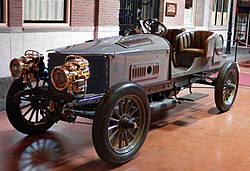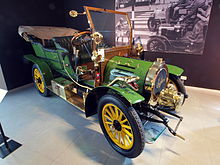| Revision as of 06:28, 4 December 2014 edit113.193.239.133 (talk) Voluntary Financial Restructuring of the company← Previous edit | Revision as of 12:12, 20 December 2014 edit undo83.163.143.150 (talk) Moving to Spyker Cars.Tag: section blankingNext edit → | ||
| Line 130: | Line 130: | ||
| The car driven by ] in the 1953 film '']'', about the ], is a 1904 Spyker 12/16-HP. | The car driven by ] in the 1953 film '']'', about the ], is a 1904 Spyker 12/16-HP. | ||
| ==Voluntary financial restructuring of the company== | |||
| Skyker filed a voluntary petition on December 2, 2014 for financial restructuring in an effort to address certain short-term operational and liquidity challenges. The company stated that the District Court of Midden-Nederland in Lelystad, the Netherlands (the “Court”) granted Spyker’s voluntary petition for temporary moratorium of payment (“surseance van betaling”), the Dutch equivalent of the American Chapter 11 proceedings, and has appointed an administrator who, together with the Board of Management, bears final responsibility for management of the company as long as the moratorium of payment status is in force. The Court’s ruling to grant a temporary moratorium of payment protects the Company from its creditors throughout the duration of the moratorium. The Company’s wholly owned subsidiary Spyker Events & Branding B.V. entered temporary moratorium of payment a month ago. <ref>{{cite web|last1=Motown |first1=India |title= Spyker files for voluntary financial restructuring|url= http://www.motownindia.com/Bureau/Corporate-News/727/Spyker-files-for-voluntary-financial-restructuring-Motown-India-Bureau#.VH_879KUePo|website=Motown India |accessdate=2 December 2014|date=2 December 2014}}</ref> | |||
| ==See also== | ==See also== | ||
Revision as of 12:12, 20 December 2014
This article is about the former car manufacturer. For the modern marque, see Spyker Cars. For other uses, see Spyker (disambiguation).| Industry | Automotive Aviation |
|---|---|
| Founded | 1880 |
| Defunct | 1926 |
| Fate | Defunct |
| Headquarters | Netherlands |
| Key people | Jacobus and Hendrik-Jan Spijker, founders |
| Products | hand-built coaches, carriages, cars and airplanes |
Spyker or Spijker was a Dutch car manufacturer, started in 1880 by coachbuilders Jacobus and Hendrik-Jan Spijker, but to be able to market the brand better in foreign countries, in 1903 the 'ij' was changed into 'y'. They were originally based in Hilversum but in 1898 moved to Trompenburg, Amsterdam.
History
In 1898 Spyker manufactured the "Golden Carriage", still in use by the Dutch King today.

In 1899 they started building automobiles and in 1900 put their first models on display, two-cylinder 3 hp and 5 hp similar to the Benz. Four-cylinder models were introduced in 1903, along with the six-cylinder Spyker 60 HP, a racer with the world's first ever four-wheel drive car with a single engine and four-wheel brakes. An engine with six cylinders was also a world's first.
The 1905 cars featured a round radiator grille which became a feature of many of the pre war cars. In 1913 the company was having financial problems again and in 1915 was taken over by new owners and renamed Nederlandsche Automobiel en Vliegtuigfabriek Trompenburg (Dutch Car and Aircraft company). Under the new owners, the previous complex model range was simplified and a new car, the 13/30 C1, introduced; sales were disappointing. In 1907, an 18 hp model successfully competed in the Peking to Paris race.
Hendrik-Jan Spijker died in 1907 when the ferry he was on when returning from England sank, and this loss led to the bankruptcy of the original company. A group of investors bought the company and restarted production, but Jacobus Spijker was no longer involved.
Before Hendrik-Jan Spijker's death, he and his brother had developed a special relationship with Dutch electrical pioneer Rento Hofstede Crull. The Spijker brothers had known Hofstede Crull already when he was a young man racing on the velocipede circuits in the Netherlands and in Germany while he was an engineering student first in Mittweida and later in Hannover at the Technische Hochschule in the 1880s. Hofstede Crull had already owned his first automobile in the 1890s. In the first decade, he had accumulated a collection of automobiles which included a number of the Spijker racing models. He housed the collection in one of the wings of the NV Heemaf, one of the companies he had founded. Although this was all a hobby for him initially, he began assembling Spijkers at Heemaf with the approval of the Spijker brothers and subsequently with that of those who had taken over SPIJKER. He provided them with improvements on the automobiles. Heemaf's board of directors complained that Hofstede Crull was using a part of the factory as his personal garage and auto park. To circumvent the criticism, he established the Spijker Automobiel Verhuur Maatschappij which along with Amsterdam's Trompenburg Bedrijf became the first auto rental companies in the Netherlands. One of his other companies was the American Refined Motor Company which helped improve mechanical motor parts. This all stemmed from an automobile accident that he, Hofstede Crull, and his chauffeur, a man named Poorthuis, had in 1909 when he subsequently discovered a defect in the Spijker's steering mechanism which he improved.
During World War I, in which the Netherlands were neutral, they manufactured aeroplanes and aircraft engines.
In 1922 the company went bankrupt again and was acquired by Spyker's distributor in Britain who renamed the company Spyker Automobielfabriek. Production continued and prices dropped but the company continued to decline. Final production was of the C2 two-ton truck and the C4 car which lasted until 1926 when funds finally ran out.
It is estimated total Spyker car production was at most 2000 cars.
In 1999, a new company, Spyker Cars was founded, unrelated to the original company but for the brand name.
Car models




| Vehicle | Year | Details |
|---|---|---|
| Spijker 3 hp | 1900–1902 | 2-cylinder |
| Spijker 5 hp | 1900-1900 | |
| Spijker 5 hp | 1900-1900 | boxer engine |
| Spijker 6 hp | 1902-1902 | water-cooled engine. |
| Spijker 10/12 | 1903-1903 | 2-cylinder |
| Spyker 20/24 | 1903–1904 | 4-cylinder |
| Spijker 36/50 | 1903-1903 | 6-cylinder 5,073 cc (309.6 cu in) |
| Spyker 60/80 | 1903–1907 | 6-cylinder 8,821 cc (538.3 cu in) |
| Spyker 16/20 | 1903–1907 | 4-cylinder |
| Spyker 30/36 | 1903–1907 | |
| Spyker 14/18 | 1904–1907 | 4-cylinder 2,544 cc (155.2 cu in) |
| Spyker 20/28 | 1904–1907 | 4-cylinder |
| Spyker 25/36 | 1904–1905 | 4-cylinder 7,964 cc (486.0 cu in). Fourwheel drive option. |
| Spyker 32/40 | 1904–1905 | 4-cylinder. Fourwheel drive option. |
| Spyker 15/22 | 1905–1907 | 4-cylinder 3,456 cc (210.9 cu in). |
| Spyker 10/15 | 1907-1907 | 4-cylinder. |
| Spyker 15/22 | 1907-1907 | 4-cylinder 2,799 cc (170.8 cu in). |
| Spyker 20/30 | 1907-1907 | 4-cylinder 4,562 cc (278.4 cu in). |
| Spyker 30/42 | 1907-1907 | 4-cylinder 6,902 cc (421.2 cu in). |
| Spyker 40/80 | 1907-1907 | 4-cylinder 10,603 cc (647.0 cu in). |
| Spyker 15/22 | 1907–1910 | 4-cylinder 2,799 cc (170.8 cu in). |
| Spyker 60/80 | 1909-1909 | 4-cylinder. |
| Spyker 10/15 | 1910–1912 | 4-cylinder. Delivery van. |
| Spyker 15/25 | 1910–1912 | 4-cylinder. Delivery van. |
| Spyker 12 | 1910–1914 | 4-cylinder. |
| Spyker 16 | 1910–1912 | 4-cylinder. |
| Spyker 18 | 1910–1912 | 4-cylinder. |
| Spyker 25 | 1910–1912 | 4-cylinder. 4,589 cc (280.0 cu in). |
| Spyker 25/30 | 1911–1912 | 6-cylinder. |
| Spyker 20 | 1912–1916 | 4-cylinder. 3,435 cc (209.6 cu in). |
| Spyker 30 | 1912–1916 | 4-cylinder. 6,082 cc (371.1 cu in). |
| Spyker 40 | 1912–1916 | 6-cylinder. 7,238 cc (441.7 cu in). |
| Spyker 14 | 1913–1916 | 4-cylinder. |
| Spyker 12 | 1914–1916 | 4-cylinder. 1,795 cc (109.5 cu in). |
| Spyker 13/30 C1 | 1916–1921 | 4-cylinder. 3,560 cc (217 cu in). |
| Spyker 14/34 C1 | 1920–1921 | 4-cylinder. 3,562 cc (217.4 cu in). |
| Spyker C2 | 1916–1926 | 4-cylinder. 4,607 cc (281.1 cu in). Two ton truck. |
| Spyker 30/40 C4 | 1920–1926 | 6-cylinder Maybach engine. 5,742 cc (350.4 cu in). |
Aircraft
Spyker on stamps and in film
Both Spyker brand automobiles appear on Dutch postage stamps (first day of issue: May 10, 2004).
The car driven by Kenneth More in the 1953 film Genevieve, about the London to Brighton Veteran Car Run, is a 1904 Spyker 12/16-HP.
See also
References
- Malcolm McKay (March 2008). "Four-wheel drive". Octane magazine. Retrieved 2009-05-24.
- Georgano, G. N. Cars: Early and Vintage, 1886-1930. (London: Grange-Universal, 1985)
- Henry, A. The 4-Wheel Drives : Racing's Formula for Failure?. (London: Macmillan, 1975)
- nl:Rento Hofstede Crull
- nl:Heemaf
- Heemaf was a public-traded company
- Jaap Tuik. Een bijzonder energiek ondernemer - Rento Wolter Hendrik Hofstede Crull (1863-1938): pioneer van de elekriciteits voorziening in Nederland- #3: Ontspanning: fiets en auto als liefhebberij. Zutphen, Nederland: Historischcentrumoverijssel & Walburg Pers., 2009. pp.: 25-31 ISBN 90-5730-640-9
- http://www.holechistorie.nl/index.php?option=com_content&view=article&id=204:auto-o...
| Spyker | |
|---|---|
| Companies: |
|
| Cars (1880-1926) | |
| Aeroplanes (1915-1926) | |
| Other | |